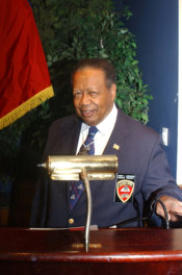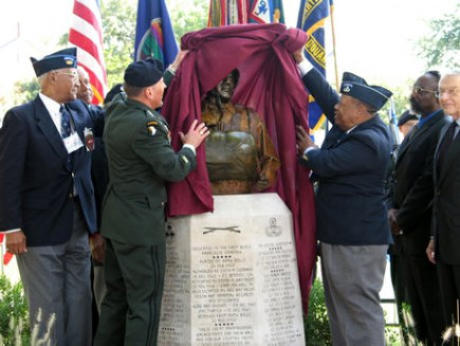


© Official Site Of 555th Parachute Infantry “Triple Nickle”. 2008












1980 - 1984
1986 – 1988
1996 - present


President Joe Murchison and
General David Petreaus
unveiling monument at Fort
Leavenworth dedicated to
the 555
th
. Located by the
Buffalo Soldier Monument.
Sixty Years After Integration, Opportunities for Minority Soldiers Abound
2nd Brigade Combat Team, 82nd Airborne Division Public Affairs
By Staff Sgt. Mike Pryor
2nd Brigade Combat Team, 82nd Airborne Public Affairs
FORT BRAGG, N.C. – By the time the Army was officially desegregated on July 26, 1948, Joe Murchison was
already a proud member of the 82nd Airborne Division.
A year earlier, his all-black Paratrooper unit, the 555th Parachute Infantry Battalion, had been absorbed into the 82nd
at the personal request of the division's legendary commander, Maj. Gen. James Gavin. As a result, Murchison and
his fellow "Triple Nickles" were some of the first black Soldiers to work and train side by side with White Soldiers.
At the time, the ugly racism of the Jim Crow-era South was inescapable, Murchison said. Off post, there were "white"
and "colored" drinking fountains, blacks were forced to ride in the back of the bus, and restaurants wouldn't serve
them. Even on Fort Bragg, white and black Soldiers had separate living quarters, and blacks were barred from the
Officer's club. But in the field, at the range, or jumping out of an airplane, Murchison and the other black paratroopers
felt they were the equal of anyone, he said. Their special airborne status earned them respect from troops of every
color.
"Paratroopers were Paratroopers, whatever their color was," Murchison said.
In the 60 years since the Armed Services were desegregated by President Harry Truman's Executive Order 9981,
opportunities for blacks and other minorities in the military have grown by leaps and bounds. In Murchison's day,
blacks were often assigned to menial jobs supporting white Soldiers, and there were few black officers. Today, blacks
account for 17 percent of all military personnel, and 11 percent of all Army officers. Black officers hold key positions at
the most senior levels of command. Indeed, the man who now sits in Jim Gavin's chair as commander of the 82nd
Airborne Division is a black man, Brig. Gen. Rodney Anderson.
Yet military leaders acknowledge there is more work to be done. While opportunity has never been greater, black
Soldiers serving today still face some of the same prejudices Murchison did 60 years ago. But they also share the
same pride.
Something to Prove
The end of segregation in 1948 did not mean the end of racist views. Murchison said black Soldiers during the period
of integration knew all eyes were on them, with some hoping they would fail.
"We knew we had something to prove and we had to be better than the best," he said.
Walter Morris, who was First Sergeant of the Army's first all-black paratrooper company, recounted the skepticism he
and his troops faced in a 1990 issue of Patriots Magazine.
"The entire post was making bets that we wouldn't jump—we'd be too afraid. The thing that inspired us was that this
was the only black combat outfit then, and it was an opportunity for black troops to enter something they could be
proud of," Morris recalled Sixty years later, some minorities still feel pressure to be better than their white peers, said
Master Sgt. Major Bryant, the Equal Opportunity Advisor for the 2nd BCT, 82nd Abn. Div.
"They feel like, 'I have to go out there and go above and beyond in order to get their attention and respect,'" Bryant
said.
Not all black Soldiers feel that pressure. Capt. Devin Henry, a staff officer with the 1st Squadron, 73rd Cavalry
Regiment, 2nd Brigade Combat Team, 82nd Abn. Div., said he never felt he was held to a different set of
expectations as a black officer than his white peers.
"I'm just another guy in the 82nd," he said.
Common Bonds
A common saying around the Army is that the only color that matters is Green. It's another way of saying that the
shared intensity of Army life tends to break down barriers between people of different ethnic or cultural backgrounds.
It was something Murchison noticed back in 1948, and black Soldiers serving today see the same thing.
"It's that common bond that pushes differences away," Henry said.
Growing up as a black kid in overwhelmingly white Newport, R.I., Henry learned a thing or two about overcoming
differences, and he brought that attitude with him in his Army career. According to Henry, race isn't invisible in today's
military; it is simply irrelevant.
"You have to look past it, you have no choice," Henry said. "You have to work as a team and put aside your
differences in order to get things done."
That process begins at Basic Training, said Henry. At Basic, whatever biases or prejudices new recruits have are
shaved away, just like the hair on their heads that gets unceremoniously buzzed off on day one.
"It's like a clean slate. From that moment on you, have to start proving yourself," he said.
As Soldiers progress in their Army careers, they develop loyalty to their units. That kind of loyalty can be a more
powerful source for bonding than racial or ethnic associations, said Bryant.
"If I've got an 82nd patch on and you've got an 82nd patch on, I'm more apt to go and talk to you whether you're
black, green, or yellow," Bryant said.
Perhaps the most important factor in overcoming racial stereotypes is the "foxhole phenomenon." Soldiers spend so
much of their time in such close proximity to each other that they can't help but get to know one another as human
beings. Murchison saw it first hand during the early days of integration.
"What happened was that the individual Soldiers – the dogfaces and the grunts – started interacting with each other,
and going home on pass together, and meeting each others' families, and that led to acceptance," Murchison said.
"The diversity you see now comes from that."
Different Perspectives
It is not only up to individual Soldiers to confront stereotypes. With the advent of the all-Volunteer military, the Army
as an institution has also made a concerted effort to combat discrimination. Several ugly incidents in the 1970s and
80s made it clear that discrimination was undermining unit cohesion and overall readiness. The response was to
create an Equal Opportunity program to end discriminatory practices and ensure all Soldiers were being treated
fairly.
Today, every brigade has an equal opportunity advisor like Bryant, a former infantry platoon sergeant who now
spends his days teaching Soldiers about the value of diversity.
"We all don't look the same or think the same, and that gives you different perspectives when you are looking at a
problem," he tells the Paratroopers who attend his class.
Bryant, who is black, said he challenges Soldiers to confront all stereotypes, not just racial ones. He uses himself as
an example. As an infantryman, he used to hold a low opinion of support specialty Soldiers. That all changed during a
deployment to Iraq when his base was attacked and he saw two cooks and an admin clerk spring into action to
secure the scene.
"I never thought those type of guys would be able to perform like that," he said.
Now he tries to teach others with similar opinions the error of their ways.
Diversity is a philosophy that has backers in high places. In recent comments to the Associated Press, Lt. Gen Lloyd
J. Austin, the No. 2 U.S. Commander in Iraq, said diversity is healthy for the military.
"We treasure diversity because it brings in a lot of different viewpoints and blends in a lot of cultures," he said. "It
makes us better."
Optimistic About the Future
After commanding an artillery battery of mixed black and white Soldiers in 1958, Murchison retired from the Army and
began a long and successful career as a businessman. Today he lives in Tampa, Fla., where he is the president of
the Triple Nickle Alumni Association.
When a reporter reached him to comment on the 60th anniversary of Army desegregation, he was just sitting down to
watch presidential hopeful Barack Obama give a speech on TV. Having grown up during a time when blacks and
whites couldn't drink from the same water fountain, he was excited about the possibility that a black man might soon
be living in the White House.
"There's a lot of opportunity out there. Much more so today," he said.
Trail blazers like Murchison deserve at least some of the credit for that. Murchison said the experiences he had as a
Paratrooper in the 82nd Airborne Division profoundly changed the way he thought about race and color.
"I don't answer to African-American. I'm All-American," he said.













